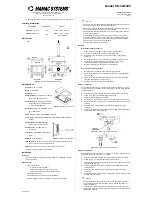
USER MANUAL V1.2
© 2014 EnOcean | www.enocean.com
TCM 310 / TCM 310C / TCM 310U User Manual | v1.2 | July 2014 | Page 24/28
TCM 310 / TCM 310C / TCM 310U
The EnOcean Duty cycle watcher implementation works as follows: the 60 minute regula-
tory interval is divided into 10 rolling time slots of equal length. For each of these time
slots, the total transmission time is recorded. In addition to that, the transmission time in
the current time slot is recorded. New telegrams will only be transmitted if the total trans-
mission time in the previous 10 time slots (representing a full 60 minute interval), the
transmission time in the current time slot, and the transmission time of the current tele-
gram combined do not exceed the regulatory limit. The time slots are rotating, freeing al-
ways the last slot.
5.2
FCC (United States) Certification
TCM 310C / TCM 310U LIMITED MODULAR APPROVAL
This is an RF module approved for Limited Modular use operating as an intentional trans-
mitting device with respect to 47 CFR 15.231(a-c) and is limited to OEM installation. The
module is optimized to operate using small amounts of energy, and may be powered by a
battery. The module transmits short radio packets comprised of control signals, (in some
cases the control signal may be accompanied with data) such as those used with alarm sys-
tems, door openers, remote switches, and the like. The module does not support continu-
ous streaming of voice, video, or any other forms of streaming data; it sends only short
packets containing control signals and possibly data. The module is designed to comply
with, has been tested according to 15.231(a-c), and has been found to comply with each
requirement. Thus, a finished device containing the TCM 310C / TCM 310U radio module
can be operated in the United States without additional Part 15 FCC approval (approval(s)
for unintentional radiators may be required for the OEM’s finished product), under EnO-
cean’s FCC ID number. This greatly simplifies and shortens the design cycle and develop-
ment costs for OEM integrators. The module can be triggered manually or automatically,
which cases are described below.
Manual Activation
The radio module can be configured to transmit a short packetized control signal if trig-
gered manually. The module can be triggered, by pressing a switch, for example.
The packet contains one (or more) control signals that is(are) intended to control some-
thing at the receiving end. The packet may also contain data. Depending on how much en-
ergy is available from the energy source, subsequent manual triggers can initiate the
transmission of additional control signals. This may be necessary if prior packet(s)
was(were) lost to fading or interference. Subsequent triggers can also be initiated as a pre-
caution if any doubt exists that the first packet didn’t arrive at the receiver. Each packet
that is transmitted, regardless of whether it was the first one or a subsequent one, will only
be transmitted if enough energy is available from the energy source.
Automatic Activation
The radio module also can be configured to transmit a short packetized control signal
if triggered automatically, by a relevant change of its inputs or in response to receiving a
signal from another transmitter, for example. Again, the packet contains a control signal
that is intended to control something at the receiving end and may also contain data. As
above, it is possible for the packet to get lost and never reach the receiver. However, if
enough energy is available from the energy source, and the module has been configured to
do so, then another packet or packets containing the control signal may be transmitted at a
later time.
The device is capable to operate as a repeater, which can receive signals from the following
list of FCC/IC approved transmitters, and retransmit the signals.





































